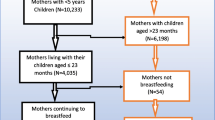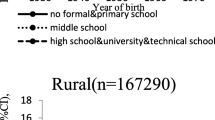Abstract
Retrospective data collected in two urban neighborhoods of Tianjin, People's Republic of China, reveal a decline in the rate and duration of breastfeeding since the mid-1930's. There is no reason to suppose that this decline was stimulated by policies intended to discourage breastfeeding, or by pressures from commercial interests determined to expand the use of milk substitutes or supplements. The evidence indicates that breastfeeding declined as women became involved in work outside the home, as they adopted a form of postmarital residence that separated them from other relatives, as income increased, and as their rural origins decreased. No evidence was found to indicate a relationship between breastfeeding and parity or sex preferences.
Similar content being viewed by others
References
Barbeau, W., Brown, D., McGreevy, J., Moreno-Black, G., Oyer, J., Post, L., Quinn, V., Ruano, S., Tajeu, K., and Velluntini, R. (1980).Appropriate Strategies to Improve Infant and Young Child Feeding. Cornell International Monograph Series 10, Cornell University Press, Ithaca, pp. 22–55.
Beaver, N. W. (1979). Population, infant mortality and milk.Population Study 27: 243–252.
Bryant, C. A., Courtney, A., Markesbery, B. A., and Dewalt, K. (1985).The Cultural Feast: An Introduction to Food and Society. West Publishing, St. Paul.
Butz, W. P., and DaVanzo, J. (1981). Determinants of breastfeeding and weaning patterns in Malaysia. Unpublished paper presented at the Annual Meetings of the Population Association of America, Washington, D.C.
Cantrelle, P., Ferry, B., and Mondot, J. (1978). Cause and sequence in the reduction of postnatal abstinence in Ibadan City, Nigeria. In Page, H. J., and Lesthaeghe, R. (eds.),The Effects of Infant and Child Mortality on Fertility. Academic Press, New York, pp. 187–192.
China Daily. Beijing (English language version).
Fang, Z. L. (1983). Wuoguo naipin gungyie canzhuang (The current trend in the Chinese milk industry).Shipin Dungtai (Food Trends) 5: 1.
Greiner, Y. H. (1975).The Promotion of Bottle Feeding by Multínational Corporations, How Advertising and Health Profession Have Contributed. Cornell International Monograph Series 2, Cornells University Press, Ithaca.
Greiner, Y. H. (1979).Regulation and Education Strategies for Solving the Bottle Feeding Problem. Cornell International Monograph 4, Cornell University Press, Ithaca.
Greiner, Y. H., Van Esterik, P., and Latham, M. C. (1981). The insufficient milk syndrome: An alternative explanation.Medical Anthropology 5: 234–246.
Guo, Y. H. (1982). Quanguo ertung yingang huiyi baogao (Report of the national conference on child nutrition).Shipin Keji (Food Science and Technology) June: 14.
Gussler, J. D., and Briesemeister, L. H. (1980). The insufficient milk syndrome: A biocultural explanation.Medical Anthropology 4: 145–174.
Gussler, J. D., and Briesemeister, L. H. (1981). Commentary.Medical Anthropology 5:248–252.
Harrell, B. B. (1981). Lactation and menstruation in cultural perspective.American Anthropologist 83: 796–819.
Hershatter, G. (1982). The making the working class in Tianjin, 1900–1949. Unpublished doctoral dissertation in anthropology, Stanford University, Stanford.
Huffman, S. L. (1984). Determinants of breastfeeding in developing countries: Overview and policy implications.Studies in Family Planning 15: 170–183.
Jain, A. K., Hsu, T. C., Freedman, R., and Chang, M. C. (1970). Demographic aspects of lactation and postpartum amenorrhea.Demography 7: 255–271.
Lin, A. (1982). Mulu yuying hao (Breastfeeding is better).Shipin Keji (Food Science and Technology) June: 14.
Lucas, D. W. (1977). Urban and rural fertility in southern Nigeria. In Ruzicka, L. (ed.),The Economic and Social Supports for High Fertility. Proceedings of conference held at Canberra, November 1976, Canberra Australian National University.
Martinez, G. A., and Nalezienski, J. (1979). The recent trend in breastfeeding.Pediatrics 64: 686–692.
Masnick, G. S. (1979). The demographic impact of breastfeeding, a critical review.Human Biology 51: 109–125.
Millman, S. (1981). Breastfeeding in Taiwan: Trends and differentials, 1966–1980. Unpublished paper presented at the annual meetings of the Population Association of America, Washington D.C.
Millman, S. (1985). Breastfeeding and contraception: Why the inverse association.Studies in Family Planning 16: 61–75.
Nag, M. (1983). The impact of socio-cultural factors on breastfeeding and sexual behavior. In Bulatao, R. A., and Lee, R. D. (eds.).Determinants of Fertility in Developing Countries (Vol. 1). Academic Press, New York, pp. 163–198.
Nerlove, S. B. (1974). Women's workload and infant feeding practices: A relationship with demographic implications.Ethnology 13: 207–215.
Pasternak, B. (1983).Guests in the Dragon: Social Demography of a Chinese District, 1895–1945. Columbia University Press, New York.
Popkin, B. M. (1983). Breastfeeding determinants in low-income countries.Medical Anthropology 7: 1–31.
Richardson, J. L. (1975). Review of international legislation establishing nursing breaks.Journal of Tropical Pediatrics and Environmental Child Health 21: 249–258.
Scrimshaw, M., and Ho, Z. C. (1981). Commentary.Medical Anthropology 5: 258–260.
Shanghai Child Health Care Coordinating Group (1975). Measurement of growth and development of infants under 20 months of age in Shanghai.Journal of Tropical Pediatrics and Environmental Child Health 21: 284–289.
Susman, G. D. (1982).Selling Mother's Milk: The Wet Nursing Business in France, 1911–1914. University of Illinois Press, Urbana-Champaign.
Wolf, A. P., and Huang, C. S. (1980).Marriage and Adoption in China, 1845–1945. Stanford University Press, Stanford.
Worthington-Roberts, B. S., Vermeersch, J., and Williams, S. R. (1981).Nutrition in Pregnancy and Lactation. C. V. Mosby, St. Louis.
Author information
Authors and Affiliations
Rights and permissions
About this article
Cite this article
Pasternak, B., Ching, W. Breastfeeding decline in urban China: An exploratory study. Hum Ecol 13, 433–466 (1985). https://doi.org/10.1007/BF01531154
Issue Date:
DOI: https://doi.org/10.1007/BF01531154




